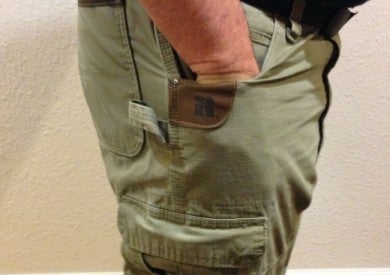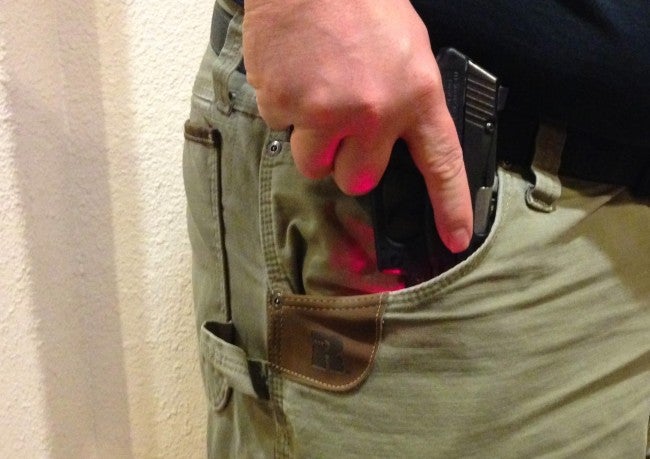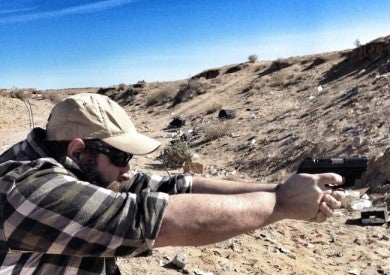At a recent gun show in Albuquerque, New Mexico, I made an impulse purchase. The Kel-Tec PF9. I had been looking for a sub-compact pistol, and wanted something light, thin, and most importantly, reliable. I had considered a Glock 26, but the shape was just too “glocky”. I had also thought about a Sig Sauer P290RS, but also didn’t want to spend quite that much.
Then, I happened upon a table that had a number of sub-compacts. I was able to do a good side-by-side comparison. Out of all of the pistols that I handled, the Kel-Tec fit my hand the best. I don’t have huge bear paws, but neither is my grip “delicate”. I did my background check, and acquired the pistol with two additional magazines.
Before leaving the show, I also found a deal on a Crimson Trace LG435 (that integrates with the trigger guard and the MIL-STD-1913 picatinny rail) which I, of course, bought and installed.
The original platform debuted in 2007. Kel-Tec describes the pistol as being a hybrid of the PF-11 and the P-3AT “combined into the flattest and lightest single stack 9mm configuration ever made”. It is certainly light at just under 13 oz dry (360 gm for my metric friends). The width is roughly 0.9 inches (22 mm). Compare that to my normal carry weapon, a Glock 17, which weighs 25 oz dry and is 1.2 inches thick. So, the PF-9 is basically half the weight and three-quarters of the width. The Kel-Tec certainly met my requirements for light and thin; I would test the reliability later.
After I bought it (remember that this purchase was more of an impulse buy), I went looking for reviews, and I found a mixed bag of positive and negative. It seems that people either love this gun, or they hate it. I didn’t really find a middle ground. I did, however, find out that a couple of buddies with the local PD carry them as backup.
Having read that one of the primary complaints was a “sticky” slide leading to failure-to-feed/failure-to-eject, I decided to pre-work the slide. I manually racked the slide two-hundred and fifty times, field stripped it, cleaned and lubed it, and repeated. I did this for six cycles (1500 repetitions), and then took it to the range. My planned course of fire was 18 “El Presidente” drills, broken down by 180 rounds of ball, and 36 rounds of “defense” ammo. After every five drills using ball, I ran one drill using defense ammo. I engaged 9 inch by 9 inch half-inch steel plates rather than shooting on standard IPSC targets (“A” zone is roughly 6 inches by 11 inches).
My Impression
First, I didn’t have a single failure. The trigger pull is quite long, and while this is a common “complaint” it is important to remember that the weapon does not have a manual safety. What did surprise me was the reset. After I fired my first round, I slowly let off on the trigger pressure until I felt the “click”, and then pressed rearward again. Nothing. I released the trigger fully and tried again. Same thing. This time I released the trigger pressure slowly all the way, and I felt a second “click”. That second click turned out to be the actual reset. I was actually “short-stroking” the trigger. Being used to the reset on a Glock is not the same as on this DA pistol; be warned. Or maybe read the manual.
Drawing from concealment was a little more challenging due to the small form factor. I did not have a traditional belt holster, and a shoulder holster (or thigh rig) would just be ridiculous. What I did have was both an ankle holster and a pocket sleeve. Generally, I’m not a fan of ankle holsters for anything other than a backup. As a primary, they are too challenging to access without some sort of subterfuge. That said, the PF-9 works wonderfully in that configuration. It rode comfortably. While I knew something was on my ankle, it was not burdensome, and it concealed very well underneath both dress pants and jeans.
The pocket sleeve was the most applicable for my intended carry. I’m sure everyone can agree that putting a naked pistol in your pocket is not the best idea, so a decent sleeve that securely covers the trigger, masks the print, and allows for a smooth draw are all important qualities. I generally wear “comfortably loose” cargo pants. I found the main front pocket to be more than adequate to hold the PF-9, allowing for positive grip on the weapon and a smooth draw without catching on anything.
The biggest issue I found was a slower draw (and the super long trigger pull). With my Glock in a IWB holster, I am a solid “C” class shooter on the “El Presidente” (faster than 11.25 seconds), and can generally pull off a “B” (at 7.5 seconds). With the PF-9, drawing from inside my front pocket, I was definitely much slower. I averaged 13.75 seconds, with my fastest time being just over 12 seconds (Disclosure: I did have a couple of “not completes” as a result of missing the target). Drawing the secondary magazine from my left pocket was also slower. Even with consistent practice, I would still be slower drawing from a pocket than from a more “tactical” holster.
Conclusion
Overall I am impressed with the platform, and it has actually become the weapon I carry most often. The ease of concealment in nearly every circumstance (excepting the occasional Speedo at the beach) makes it the weapon I am mostly likely to have on me.
While drawing the PF-9, under duress, from a pocket, is slower, it was still manageable. Since the pistol is just so easy to slip in a pocket, it is more likely to be on me (opposed to having to plan my clothing choices around my carry strategy). And my philosophy dictates that the best weapon during a gunfight is the operable one you have with you…
Pros
- Very light and small profile
- Long trigger pull and no manual safety
Cons (and these are really personal issues)
- Coming from a Glock, the trigger reset operation was unexpected and required some retraining.
- Long trigger pull (seems like forever to reach the break)
The important thing to remember when carrying any weapon is to be familiar with it’s operation as well as it’s peculiarities. The PF-9, with consistent practice, is a fine weapon and one that has earned a place in my Everyday Carry loadout.
Manufacturer Specifications
Model Number: PF-9
Action Type: Double Action Only
Caliber: 9mm Luger
Capacity: 7 + 1
Length: 5.85”
Barrel Length: 3.1”
Height: 4.3”
Width: 0.88”
Weight: 12.7 oz
Trigger Pull: 5 lbs
Sights: Front post, adjustable rear (windage)
Price: MSRP-$333 (street-$250)
We are committed to finding, researching, and recommending the best products. We earn commissions from purchases you make using the retail links in our product reviews. Learn more about how this works.
 Your Privacy Choices
Your Privacy Choices




